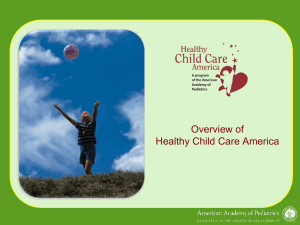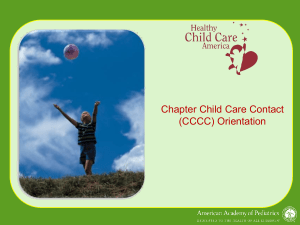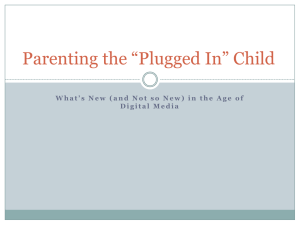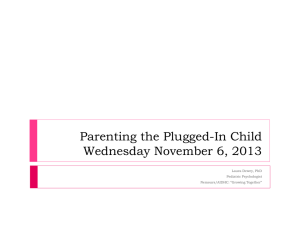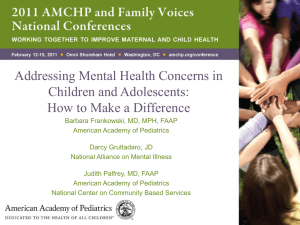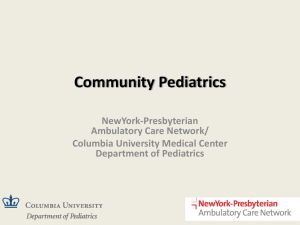The Medical Home - Healthy Child Care America
advertisement
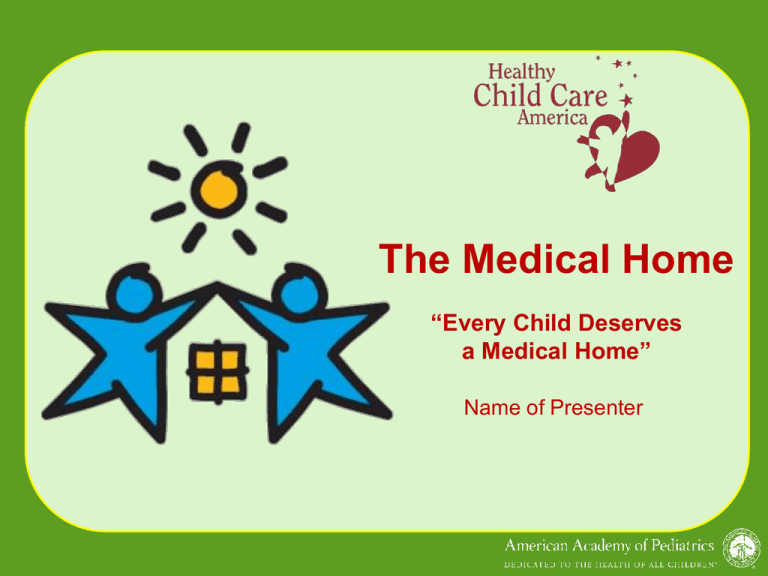
The Medical Home “Every Child Deserves a Medical Home” Name of Presenter Medical Home Outline • What is a medical home? • Why is a medical home important? • The role of: – – – – Child care program Child care health consultant Medical home State • Medical home resources www.healthychildcare.org Medical Home What is a Medical Home? You may have heard others use: – “health home” – “primary care home” – “advanced primary care” – “medical home neighborhood” The AAP will refer to this concept as a “patient- and family-centered medical home” www.healthychildcare.org Medical Home What is a Medical Home? Care that is… Accessible Continuous Coordinated Culturally competent Family-centered Comprehensive Compassionate A concept rather than a building www.healthychildcare.org Medical Home What is a Medical Home? • A partnership among children, their families, & their pediatrician (or other health professional) • Connections to support systems & services to meet the needs of the children & their families • Respect for the cultural & religious beliefs of the children & their families • Includes child care providers who feel supported in their work to provide healthy & safe environments for the children in their care www.healthychildcare.org Medical Home Medical Subspecialists Public/ Private Agencies Cultural Supports Child Care Family to Family Support Educational Services Medical Home Child/Family Religious/ Spiritual Support Transition Planning Financial Assistance www.healthychildcare.org Central Medical Record & Care Plan Medical Home Why is a Medical Home Important? • Enhanced efficiency for children & families • Family feels supported at all stages of their child’s development • Improved coordination of care www.healthychildcare.org Medical Home Why is a Medical Home Important? • Efficient use of limited resources; connection to information & support • Opportunities for professionals to gain expertise & competence • A forum for problem solving • Identification of community needs & strategies for addressing them www.healthychildcare.org Medical Home Case Scenario At 18 months old, Jason started to walk. Now that Jason is 22-months-old, a child care provider notices that Jason still seems unsteady and has not mastered this skill. What are some actions that can be taken? www.healthychildcare.org Medical Home Child Care Program’s Role www.healthychildcare.org Medical Home Child Care Program • Establish a close & open relationship with families • Document all services the child is receiving outside the facility • Include health report in child’s file Ex: – Immunizations – Screening tests • Assist families in obtaining information about & eligibility for Children’s Health Insurance Program or Medicaid • Help families find a medical home if they don’t have one www.healthychildcare.org Medical Home Child Care Program • Ask parents to discuss certain concerns/issues with their medical home • Obtain written parental consent to exchange information with the child’s medical home • Talk directly with the medical home for clarification about a child’s care or health needs – eg, asthma, allergies, diabetes • If injury or illness occurs, provide the family with a copy of the symptom/injury record to give to the medical home www.healthychildcare.org Medical Home Child Care Program • Work with CCR&Rs to maintain a list of community professionals & agencies • Work with a child care health consultant • If services are provided within the child care program, ensure that this information gets back to the medical home – Immunizations – Developmental screening www.healthychildcare.org Medical Home Child Care Health Consultant’s Role www.healthychildcare.org Medical Home Child Care Health Consultants • Promote communication among the medical home, child care program, & family • Educate families & child care providers about medical home concepts • Develop/implement health policies that are family-centered www.healthychildcare.org Medical Home Child Care Health Consultants • Assist child care programs in compiling community/health resource files • Educate pediatricians about early education & child care issues www.healthychildcare.org Medical Home The Medical Home and Child Care www.healthychildcare.org Medical Home Starting the Conversation Use Bright Futures 1 Month Visit: • Who watches the baby for you? • How do you feel about returning to work/school? • Have you made arrangements for child care? 2 Month Visit: • What have you done about locating someone for child care when you return to work/school? • Are you comfortable with these arrangements? 9 Month Visit: • What are your thoughts about discipline? Have you discussed these issues with your child care provider? www.healthychildcare.org Medical Home Starting the Conversation • Address any concerns the family might have about the child care setting • Acknowledge the family’s feelings about returning to work or school & starting child care • Remind mothers that they can still continue breastfeeding www.healthychildcare.org Medical Home Communication With Child Care • Obtain contact information for the child care program & written parental consent to exchange information • Make sure the child is up-to-date on immunizations & health screenings, & complete admission forms • Contact the child care program, introduce yourself, & provide your contact information www.healthychildcare.org Medical Home Acute Conditions • Acute illness or injury may occur in child care • Review information on signs/symptoms from the parent & child care provider – Symptom Record – Injury Report • Simplify treatment recommendations & medications – Written instructions, clear language with no jargon – Consider state laws & policies – If child is excluded, discuss when child can return www.healthychildcare.org Medical Home Children With Special Needs Develop a written plan of care with the family & caregiver – Specific medical information – Special medication or medical procedures that may be required on a routine basis – Modifications needed in daily activities • Eg, diet, transportation, changes in the physical environment – Special emergency response information www.healthychildcare.org Medical Home Children With Special Needs The Care Plan is: – Completed by the child’s health care professional – Reviewed by parents – Implemented by child care providers www.healthychildcare.org Medical Home Developmental Concerns • AAP recommends developmental surveillance & screening activities be performed in the medical home • Child care programs may bring developmental concerns up to parents or actually perform developmental screening that suggests delays. These concerns should be relayed to the child’s medical home to pursue a formal assessment. www.healthychildcare.org Medical Home Developmental Concerns • Be willing to follow up on developmental concerns that child care providers may have • Remember that the child care provider is a key partner in the care of the child – Opportunities to observe the child over an extended period! – Training in early childhood development www.healthychildcare.org Medical Home Developmental Concerns • Ask the family about contributing factors at home & child care • Offer to speak with the child care provider • Consider doing an on-site observation at the child care program • Develop a written care plan for the child www.healthychildcare.org Medical Home Don’t Forget About CCHCs! • A child care health consultant (CCHC) is a health care professional who has interest in and experience with children, has knowledge of resources and regulations and is comfortable linking health resources with facilities that provide primarily education and social services. – – – – Needs assessment Training Telephone advice Referrals to community services CCHCs can be a liaison between the child care program & medical home! www.healthychildcare.org Medical Home The State’s Role www.healthychildcare.org Medical Home The State’s Role • Help link child care programs with community resources • Encourage social service organizations to reach out to child care programs • Partner with the Division for Children with Special Health Care Needs to identify children with developmental delays (Part B & Part C of IDEA) • Promote the use of trained child care health consultants www.healthychildcare.org Medical Home The State’s Role • Work with CCHCs & child care programs to enhance the identification & referral of children at risk for social, emotional, or behavior disorders • Enforce pre-employment physical requirement for child care providers & advocate for health promotion activities • Design/implement parent education initiatives to promote positive home environments & overall child outcomes www.healthychildcare.org Medical Home The State’s Role • ECCS includes “access to health care and medical homes” as one of their 5 components • State plan goal examples: – CO: Increased number of children who receive a medical home approach; Increased number of children who are fully immunized – OK: Increase in numbers of children covered by insurance and enrolled in primary health care – NC: Enhance the commitment to medical homes across agencies and communities through social marketing strategies. www.healthychildcare.org Medical Home Back to Our Case Scenario… www.healthychildcare.org Medical Home Case Scenario At 18 months old, Jason started to walk. Now that Jason is 22-months-old, a child care provider notices that Jason still seems unsteady and has not mastered this skill. What are some actions that can be taken? www.healthychildcare.org Medical Home Case Scenario At 18 months old, Jason started to walk. Now that Jason is 22-months-old, a child care provider notices that Jason still seems unsteady and has not mastered this skill. The child care provider discusses this concern with Jason's mom, and asks if the center's CCHC can perform a developmental screening test on her son. With the mother's consent, the CCHC performs the test and finds that Jason my have a developmental delay and should see his pediatrician. The CCHC faxes the results to Jason's pediatrician and speaks to the pediatrician on the phone (with mother's consent). The pediatrician refers the child for a neurodevelopmental assessment and follows up to make sure the intervention includes the child care program. www.healthychildcare.org Medical Home Resources www.healthychildcare.org www.MedicalHomeInfo.org Marketing Materials • AAP/National Center materials • Fact sheets • Brochures for families • Brochures for physicians • Posters • Media www.medicalhomeinfo.org/quick_links/ma rketing_materials.aspx Medical Home Pediatric Care Plan Template www.healthychildcare.org Medical Home Other Care Plans www.ucsfchildcarehealth.org/pdfs/forms/SpecialHealthCare.pdf www.state.nj.us/health/forms/ch-15.pdf www.healthychildcare.org Medical Home The Pediatrician’s Role in Promoting Health and Safety in Child Care • Valuable resource for pediatricians • Describes 3 levels of involvement: – Providing guidance to families – Providing health consultation to child care programs – Advocating for quality child care http://tinyurl.aap.org/pub38947 www.healthychildcare.org Medical Home Caring for Our Children National Health and Safety Performance Standards: Guidelines for Out-of-Home Child Care Programs, 2nd Ed • Primary reference for health & safety in child care! • 707 standards & recommendations • Developed by AAP/APHA • Promoting the Medical Home - a smaller document with only standards related to the medical home nrckids.org/SPINOFF/MEDHOME/MedHome.htm • Full text is available at: nrckids.org/CFOC/index.html • Print copies from AAP, APHA, NAEYC: http://tinyurl.aap.org/pub38873 www.healthychildcare.org Medical Home Managing Chronic Health Needs in Child Care and Schools Includes more than 35 quick-access fact sheets that describes specific conditions, like: – Allergies – Asthma – Autism – Diabetes – Heart conditions & Defects – Seizures Also includes: – – – – Care plans Emergency planning recommendations Ready-to-use sample letters & forms Info on medication administration issues http://tinyurl.aap.org/pub92742 (Available as an AAP eBook) www.healthychildcare.org Medical Home www.healthychildcare.org For additional resources, visit the Healthy Child Care America Web site (a program of the American Academy of Pediatrics), which includes: • • • • • The Pediatrician’s Role Child care health consultation E-News Searchable Resource Library AAP Chapter Child Care Contacts E-Mail: childcare@aap.org Web site: www.healthychildcare.org Phone: 888/227-5409 www.healthychildcare.org Medical Home References • American Academy of Pediatrics, American Public Health Association, and National Resource Center for Health and Safety in Child Care and Early Education. Caring for Our Children: National Health and Safety Performance Standards: Guidelines for Out-of-Home Child Care Programs, 2nd edition. Elk Grove Village, IL: American Academy of Pediatrics and Washington, DC: American Public Health Association; 2002 • American Academy of Pediatrics; Council on Children With Disabilities, Section on Developmental Behavioral Pediatrics, Bright Futures Steering Committee and Medical Home Initiatives for Children With Special Needs Project Advisory Committee. Identifying infants and young children with developmental disorders in the medical home: an algorithm for developmental surveillance and screening. Pediatrics. 2006;118(1):405-420 • American Academy of Pediatrics, Medical Home Initiatives for Children With Special Needs Project Advisory Committee. The medical home. Pediatrics. 2002;110:184-186 • American Academy of Pediatrics. The Pediatrician's Role in Promoting Health and Safety in Child Care. Elk Grove Village, IL: American Academy of Pediatrics; 2001 www.healthychildcare.org Medical Home References • • • • • • Aronson SS, Shope TR. Managing Infectious Diseases in Child Care and Schools: A Quick Reference Guide. 2nd ed. Elk Grove Village, IL: American Academy of Pediatrics; 2009 Boller K, Kirby G, Moodie S, et al. Compendium of Quality Rating Systems and Evaluations. Washington, DC: Child Trends and Mathematica Policy Research; 2010. Available at www.acf.hhs.gov/programs/opre/cc/childcare_quality/compendium_qrs/qrs_com pendium_final.pdf Donoghue EA, Kraft CA. Managing Chronic Health Needs in Child Care and Schools: A Quick Reference Guide. Elk Grove Village, IL: American Academy of Pediatrics; 2010 Early Childhood Colorado Framework. 2008. Available at http://eccs.hrsa.gov/PlansModels/docs/COstateplan.pdf Early Childhood Comprehensive Systems Web site. Available at http://eccs.hrsa.gov/Resources/component-areas.htm. Accessed September 7, 2010 Hagan JF, Shaw JS, Duncan PM, eds. Bright Futures: Guidelines for Health Supervision of Infants, Children, and Adolescents, Third Edition. Elk Grove Village, IL: American Academy of Pediatrics; 2008 www.healthychildcare.org Medical Home References • National Center for Medical Home Implementation Web site. Available at www.medicalhomeinfo.org/about/faqs.aspx. Accessed August 12, 2010 • National Child Care Information and Technical Assistance Center, National Association for Regulatory Administration. The 2008 Child Care Licensing Study. Lexington, KY: National Association for Regulatory Administration; 2010. Available at www.naralicensing.org/displaycommon.cfm?an=1&subarticlenbr=205 • National Child Care Information and Technical Assistance Center Web site. CCDF Quality Activities for FY 2010–2011: Early Childhood Health Consultants and Health Activities. Available at http://nccic.acf.hhs.gov/poptopics/consultants.html. Accessed September 7, 2010 • North Carolina’s Plan for a Comprehensive Early Childhood System. Available at http://eccs.hrsa.gov/PlansModels/stateplans/docs/northcarolinastateplan.pdf Resource: NC Medical Home Campaign www.nchealthystart.org/outreach/medicalhome • Oklahoma State Department of Health. Progress Report. Available at http://eccs.hrsa.gov/PlansModels/stateplans/docs/oklahoma-implement-plan.pdf www.healthychildcare.org Medical Home Questions? www.healthychildcare.org
